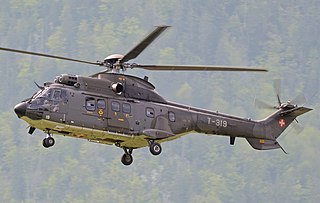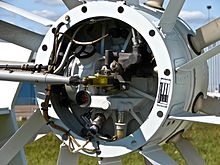Airbus Helicopters SAS is the helicopter manufacturing division of Airbus. It is the largest in the industry in terms of revenues and turbine helicopter deliveries. Its head office is located at Marseille Provence Airport in Marignane, France, near Marseille. The main facilities of Airbus Helicopters are at its headquarters in Marignane, France, and in Donauwörth, Germany, with additional production plants in Canada, Brazil (Helibras), Australia, Spain, Romania, the United Kingdom and the United States. The company, originally named Eurocopter, was rebranded Airbus Helicopters on 2 January 2014.
Messerschmitt-Bölkow-Blohm (MBB) was a West German aerospace manufacturer. It was formed during the late 1960s as the result of efforts to consolidate the West German aerospace industry; aircraft manufacturer Messerschmitt AG merged with the civil engineering and aviation firm Bölkow in 1968, while rival aircraft manufacturer Hamburger Flugzeugbau was acquired by the company in the following year.

The EurocopterAS365 Dauphin (Dolphin), also formerly known as the Aérospatiale SA 365 Dauphin 2, is a medium-weight multipurpose twin-engine helicopter produced by Airbus Helicopters. It was originally developed and manufactured by French firm Aérospatiale, which was merged into the multinational Eurocopter company during the 1990s, and since 2014 Eurocopter was renamed Airbus Helicopters. Since entering production in 1975, the type has been in continuous production for more than 40 years, with the last delivery in 2021. The intended successor to the Dauphin is the Airbus Helicopters H160, which entered operational service in 2021.

The EurocopterAS565 Panther is the military version of the Eurocopter AS365 Dauphin medium-weight multi-purpose twin-engine helicopter. The Panther is used for a wide range of military roles, including combat assault, fire support, anti-submarine warfare, anti-surface warfare, search and rescue, and medical evacuation.

The EurocopterEC120 Colibri ("hummingbird") is a five-seat, single-engine, light utility helicopter. Jointly designed and developed by Eurocopter, China National Aero-Technology Import & Export Corporation (CATIC), Harbin Aviation Industries (Group) Ltd (HAIG) and Singapore Technologies Aerospace Ltd (STAero) at Eurocopter France's Marignane facility, the EC120B was assembled by Eurocopter in France and Australia.

The Airbus Helicopters H215 is a four-bladed, twin-engined, medium-sized, utility helicopter developed and initially produced by French aerospace company Aérospatiale. It has been subsequently manufactured by the successor companies Eurocopter and Airbus Helicopters. The Super Puma is a re-engined and more voluminous version of the original Aérospatiale SA 330 Puma.

The Eurocopter EC135, now Airbus Helicopters H135, is a twin-engine civil light utility helicopter produced by Airbus Helicopters, formerly known as Eurocopter. It is capable of flight under instrument flight rules (IFR) and is outfitted with a digital automatic flight control system (AFCS). First flying in February 1994, it entered service in 1996. 1,400 have been delivered up to September 2020, to 300 operators in 60 countries, accumulating over 5 million flight hours. It is mainly used for air medical transport (medevac), corporate transport, law enforcement, offshore wind support, and military flight training. Half of them are in Europe and a quarter in North America. The H135M, certified under the name Eurocopter EC635, is a military variant. So the overall design is known as the Airbus Helicopters H135 and the military version, as the Airbus Helicopters H135M. The EC135/H135 is a development of the older Messerschmitt-Bölkow-Blohm (MBB) Bo 105.

The tail rotor is a smaller rotor mounted vertically or near-vertically at the tail of a traditional single-rotor helicopter, where it rotates to generate a propeller-like horizontal thrust in the same direction as the main rotor's rotation. The tail rotor's position and distance from the helicopter's center of mass allow it to develop enough thrust leverage to counter the reactional torque exerted on the fuselage by the spinning of the main rotor. Without the tail rotor or other anti-torque mechanisms, the helicopter would be constantly spinning in the opposite direction of the main rotor when flying.

On a helicopter, the main rotor or rotor system is the combination of several rotary wings with a control system, that generates the aerodynamic lift force that supports the weight of the helicopter, and the thrust that counteracts aerodynamic drag in forward flight. Each main rotor is mounted on a vertical mast over the top of the helicopter, as opposed to a helicopter tail rotor, which connects through a combination of drive shaft(s) and gearboxes along the tail boom. The blade pitch is typically controlled by the pilot using the helicopter flight controls. Helicopters are one example of rotary-wing aircraft (rotorcraft). The name is derived from the Greek words helix, helik-, meaning spiral; and pteron meaning wing.

The Airbus Helicopters H145 is a twin-engine light utility helicopter developed and manufactured by Airbus Helicopters. Originally designated as the BK 117, the H145 is based upon the MBB/Kawasaki BK 117 C1, which became a part of the combined Eurocopter line-up in 1992 with the merger of Messerschmitt-Bölkow-Blohm's helicopter division of Daimler-Benz into Eurocopter. The helicopter was earlier named EC145; an updated version, EC145 T2, was renamed H145 in 2015.

The EurocopterEC130 is a single engine light utility helicopter developed from the earlier Eurocopter AS350 Écureuil, one of the primary changes from which was the adoption of a Fenestron anti-torque device in place of a conventional tail rotor. It was launched and produced by the Eurocopter Group, which would later be rebranded as Airbus Helicopters.

The EurocopterAS355 Écureuil 2 is a twin-engine light utility helicopter developed and originally manufactured by Aérospatiale in France.

The Eurocopter EC155 is a long-range medium-lift passenger transport helicopter developed by Eurocopter from its Dauphin family for civil aviation use. It is a twin-engined aircraft and can carry up to 13 passengers along with 1 or 2 crew, depending on customer configuration. The helicopter is marketed for passenger transport, offshore support, VIP corporate transport and casualty transport duties. In 2015, the EC155 was formally renamed to the H155, in line with Eurocopter's corporate rebranding as Airbus Helicopters. It was succeeded in the product line by the Airbus Helicopters H160.

The Eurocopter EC635 is a multi-purpose light helicopter developed by Eurocopter as a military version of the Eurocopter EC135. It is a twin-engined aircraft and can carry up to 8 people, including the pilot, and a range of military equipment or armaments. The helicopter is marketed for troop transport, medical evacuation, cargo transport, reconnaissance and surveillance and armed combat support missions.

The Aérospatiale SA 360 Dauphin was a single-engine French utility helicopter developed and produced by aerospace manufacturer Aérospatiale.

Blue Edge is an advanced design of rotor blade developed and produced by multinational helicopter manufacturer Airbus Helicopters in cooperation with the French aerospace laboratory ONERA and the German Aerospace Center, purposed to achieve a meaningful reduction in both noise emissions and vibration as well as enhancement in aerodynamic efficiency for helicopters' operations.

The Eurocopter X³(X-Cubed) is a retired experimental high-speed compound helicopter developed by Airbus Helicopters. A technology demonstration platform for "high-speed, long-range hybrid helicopter" or H³ concept, the X³ achieved 255 knots in level flight on 7 June 2013, setting an unofficial helicopter speed record. In June 2014, it was placed in a French air museum in the village of Saint-Victoret.

The Airbus Helicopters H160 is a medium utility helicopter developed by Airbus Helicopters. Formally launched at Heli-Expo in Orlando, Florida on 3 March 2015, it is intended to replace the AS365 and EC155 models in the firm's lineup. In June 2015, the first test flight took place. It received its EASA type certification in July 2020, and first deliveries were in December 2021.
René Mouille was a French engineer, and designer of many of France's most well-known and important helicopters, widely flown by many air forces around the world.

Hélicoptères Guimbal is a French helicopter manufacturing company. The company produces the Guimbal Cabri G2.





















